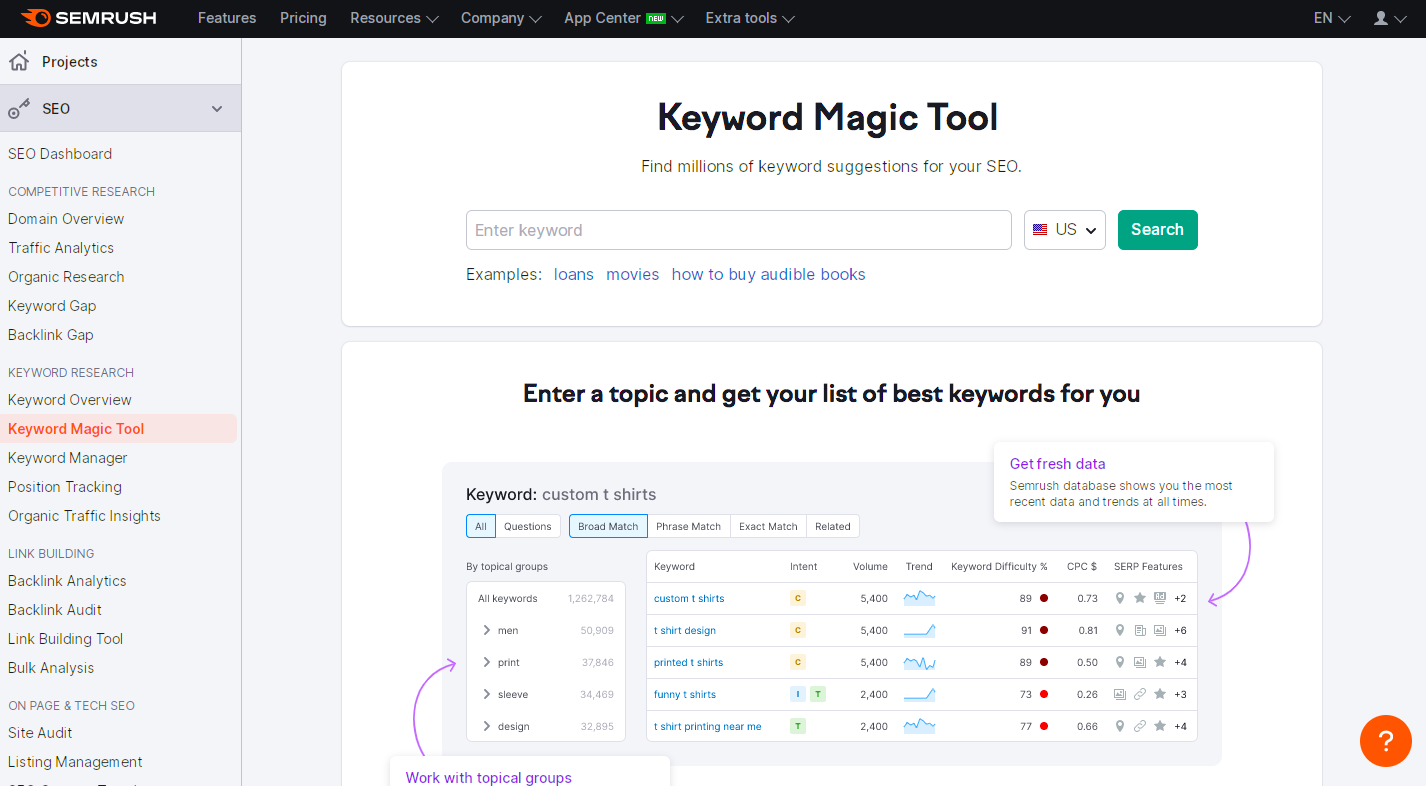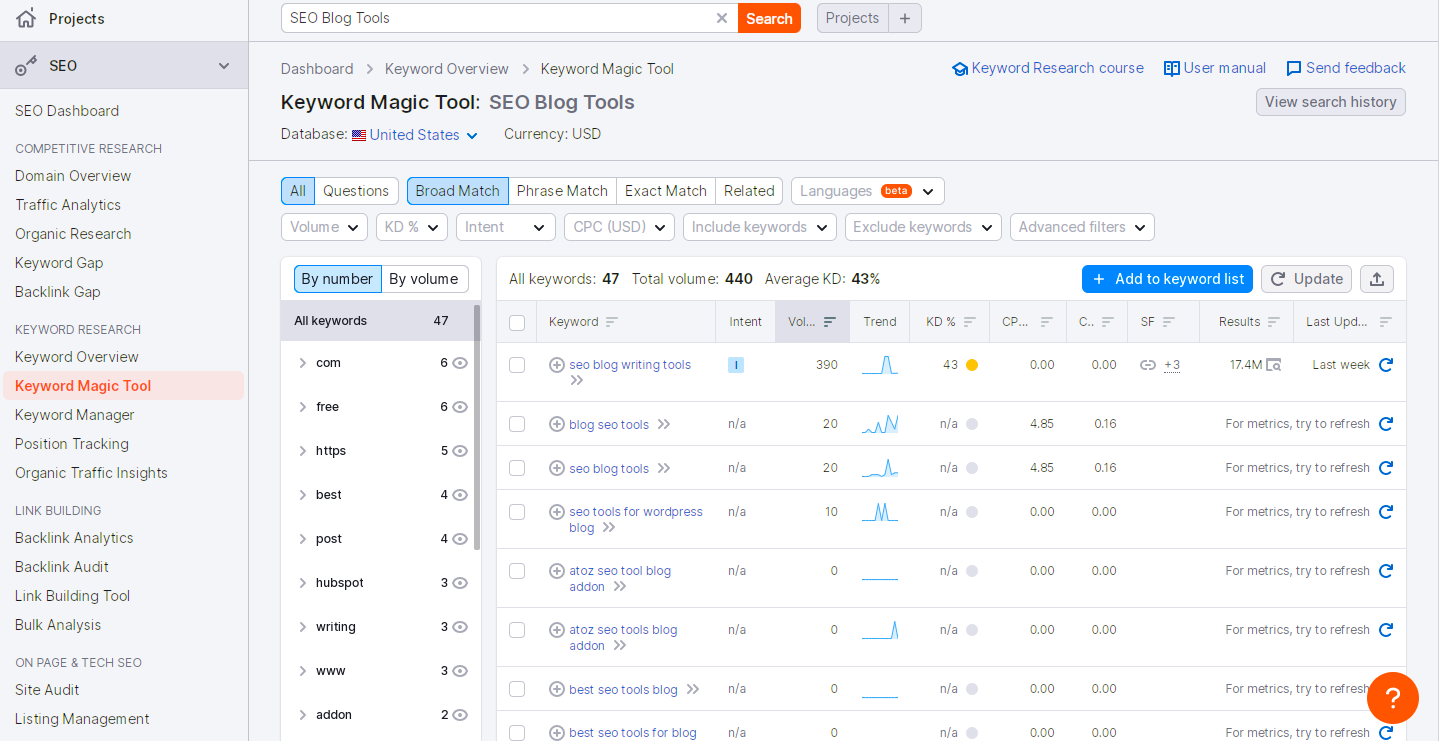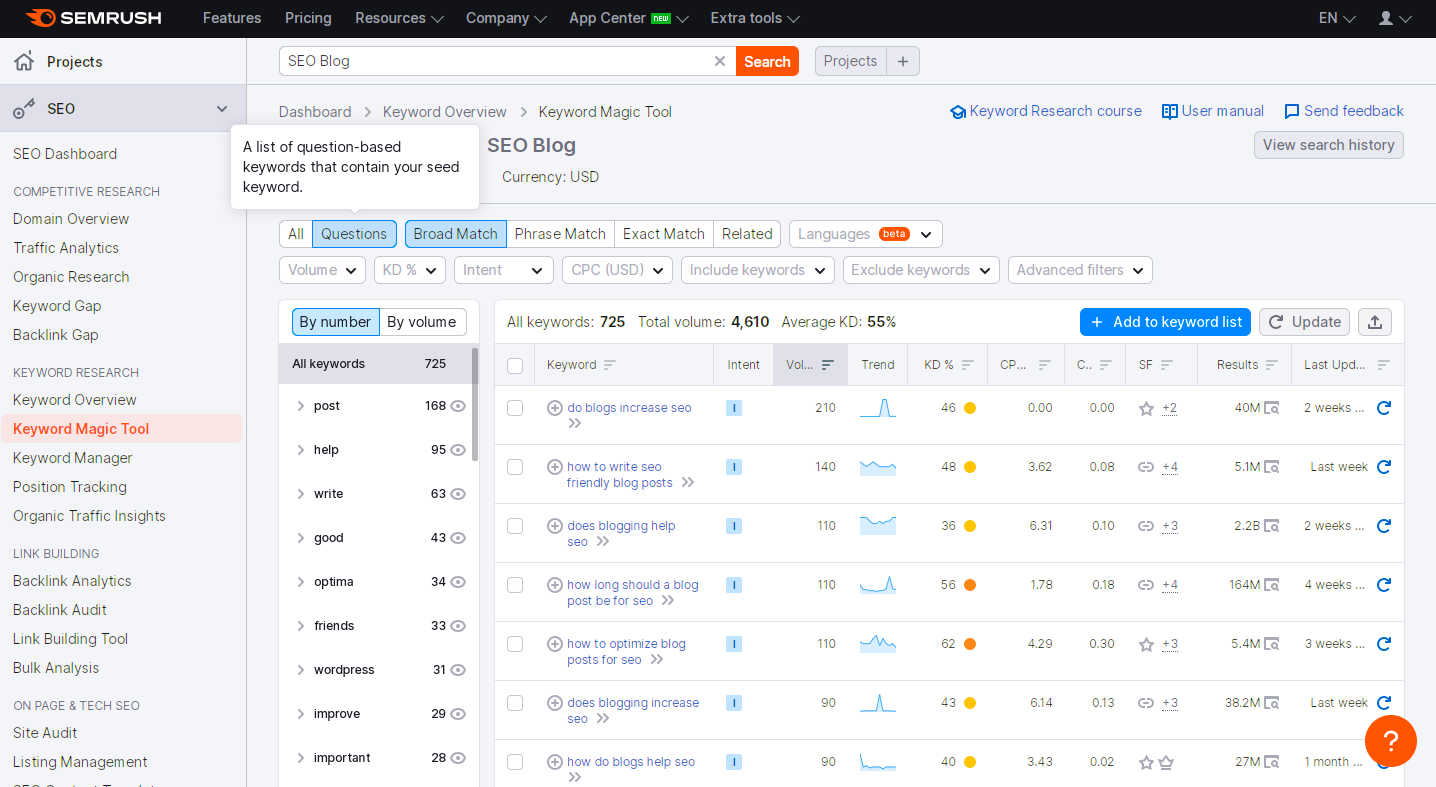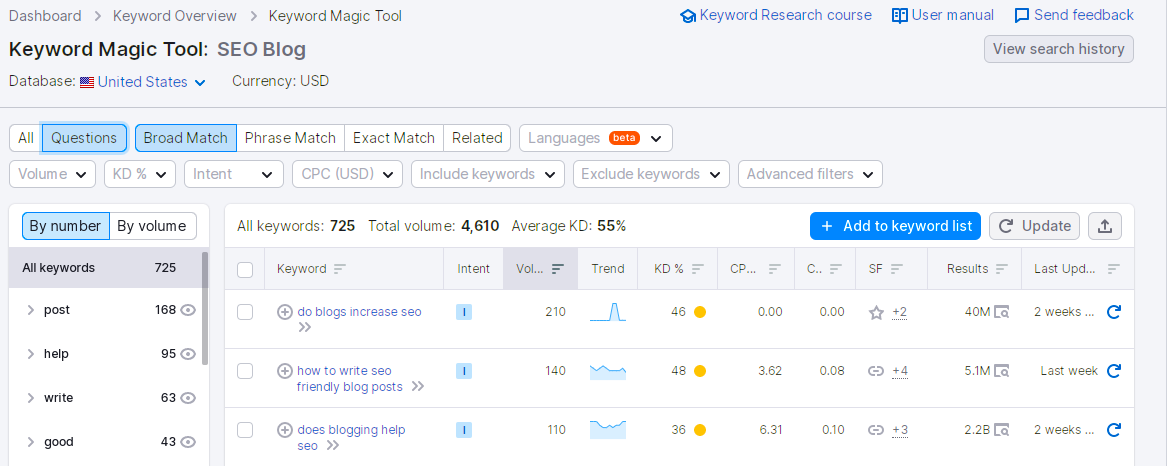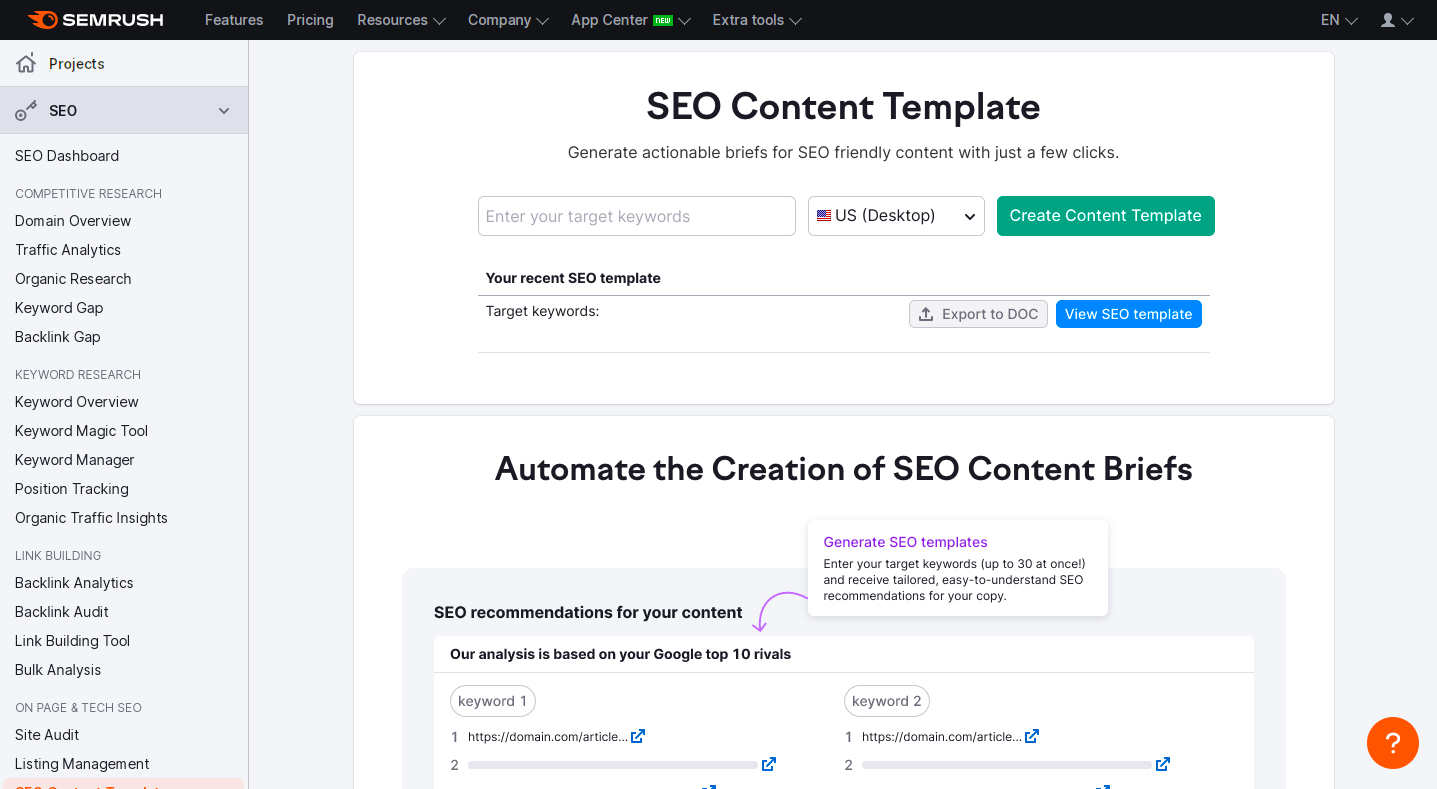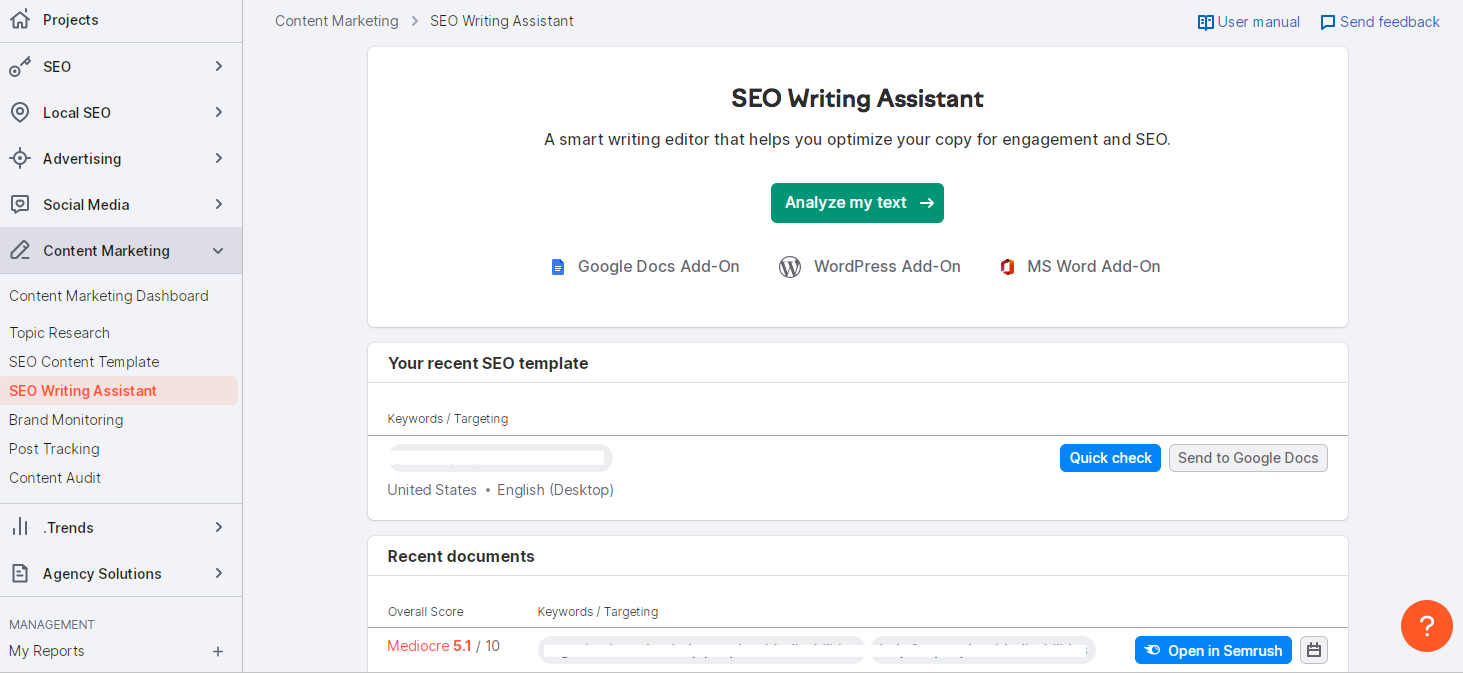Struggling to write with SEO in mind? Not a problem. All you need are great SEO blog writing tools to write amazing content that drives organic traffic and adds value for your target audience. That’s why our SEO team relies on SEMRush. Their SEO tools take the guesswork out of writing blog posts and working with website copywriters.
Consider what these three SEO blog writing tools could do for your business. With SEMRush, you can:
- Determine your blog’s topic with a focus keyword. Just use the Keyword Magic Tool!
- Get an edge on the competition! Review their SEO practices with the SEO Content Template.
- Breeze through the drafting process. Write with SEO best practices using the SEO Writing Assistant.
Blogs are a fantastic way to expand your website’s SEO reach. Do you want to provide relevant answers to your customer’s questions, rank higher in search, and grow your website’s organic search traffic? That’s what a blog can do for your business. Read on and let SEMRush put you on the path to SEO blog writing success.
1. Determining a Focus Keyword
What is a Focus Keyword?
Finding your focus keyword helps you optimize your post for SEO, but what is it? Simply put, a focus keyword is what your post is about, using terms that your target audience is most likely to search.
Your focus keyword should be placed in all the important places on your page: title, headings, text, URL, etc. Each page on your website should use one focus keyword, and SEMRush’s Keyword Magic Tool is a great way to find it.
How to Use the Keyword Magic Tool
The Keyword Magic Tool is a power-packed resource for any SEO blog writer. It lets you analyze an entire search market, study niche topics and groups, and save your research as you go. Take a look at how easy it is to use.
Start with Your Seed Keyword
First, type a keyword you want to analyze into the search bar. From this, the Keyword Magic Tool will generate a list of related terms with a variety of stats, including Volume and KD% (Keyword Difficulty). Those stats will come in handy later. First, you need to make the most of your keyword search. You need to filter for question keywords.
Filter for Question Keywords
Why should you filter your keyword search for question keywords? Often, people type questions rather than search terms into the search bar. Those questions can be a treasure trove of blog post ideas.
Using the Questions button to modify your search allows you to see keywords in question form. This makes it easy for you to build a list of common questions related to your keyword. It allows you to write blog posts that target a question-based keyword simply by providing an answer.
Factors When Selecting a Focus Keyword
The Keyword Magic Tool and Questions button help you discover enticing focus keywords for your blog posts. How do you pick the right one? Here are three factors to consider:
- Popularity: Does the keyword have a decent search volume?
- Relevancy: Does the keyword match what your target audience is likely searching for?
- Rankability: Are there too many competitors using the focus keyword?
This is where the Volume and KD% metrics come in. Let’s look at how they help you find the perfect focus keyword for your post.
The Volume represents the combined average monthly search volume. It helps you determine a potential keyword’s popularity and see if it’s relevant to what your target audience is looking for.
Meanwhile, the KD% shows you how hard it will be for you to rank high for a keyword. This percentage is based on content from your competitors, helping your rank higher. You’ll want to choose relevant keywords with high total volume and low average difficulty in your content marketing or SEO efforts.
With these factors in mind, you’ll be able to choose just the right focus keyword, but that’s only the beginning. If you want to outrank your rivals, you need to see what you’re up against and develop a plan that puts your posts ahead of the pack.
2. Reviewing the Competition
What is the SEO Content Template Tool?
Knowing your keywords is only the first step in writing a blog post that brings traffic to your website. Next, you need to know how to use those keywords to climb to the top of search results and boot your competitors down the line.
That’s where the SEO Content Template Tool comes in. It helps blog writers plan SEO-friendly content by generating writing recommendations based on your keywords. These recommendations help you write quality posts that leave your competitors’ content in the dust. But how do these recommendations help you write great content? Why should you use the SEO Content Template?
Why Should You Use the SEO Content Template?
Before you can write your blog post, you need to know what to include and how to include it. Do you want to create fully optimized blog posts? Build links to your new content? Draw traffic to your website with information that’s valuable to your target audience? The SEO Content Template helps you do all these things. It will:
- Suggest semantically related keywords to use in addition to your focus keyword.
- Show you where and how your competitors used your keywords on their own pages.
- Recommend best practices for your post based on the top 10 Google search results for your target keywords.
- Provide a list of websites from which to get backlinks.
- Give you a target text length and readability score to aim for when you write.
- Offer live integration with Google Docs and other platforms, so that when you’re ready to write, you have everything you need in one place.
With the SEO Content Template Tool, you can plan a fully optimized post that places you ahead of your rivals in search results. All that’s left is to write it, and SEMRush has the perfect tool for that task.
3. Writing a Blog Post with SEO
What is the SEO Writing Assistant?
Writing with SEO isn’t just about the keywords. It’s also about knowing how to insert your keywords for the highest SEO potential. In addition, it’s about originality, reading ease, and an on-brand tone of voice that keeps readers on the page. The SEO Writing Assistant was built specifically for tasks like these.
Features of the SEO Writing Assistant
1. SEO
The SEO Writing Assistant Tool will ask you to enter your blog’s target keywords. As you begin to write, the tool will show you the number of times you’ve used your keywords in the text. It will provide you with recommendations to improve your blog’s SEO capabilities.
2. Readability
This feature analyzes your text using the Flesch Reading Ease readability test. To do this, the SEO Writing Assistant looks at word difficulty and length, sentence complexity and length, and other factors. From this, it awards you a score on a scale of 100. (Recommended score is between 60 and 80 percent.) Knowing your current score allows you to edit for best readability.
The SEO Writing Assistant also compares your blog’s word count with the top 10 Google search results for your target keywords. By looking at your rivals’ blog word counts, it gives you a recommended word count for yours.
3. Originality
Google aims to provide users with the most helpful content on the web. The last thing they want is to offer search results that repeat what’s already been said. This is why original content ranks higher in search. The SEO Writing Assistant screens your content for uniqueness to ensure that you’re not saying something similar to your competitors. It’s just one more way this powerful tool helps your content climb to the top.
4. Tone of Voice
Every brand has a unique tone of voice designed with its target audience in mind. The Writing Assistant add-on ensures that you remain on-brand in the type of language you use. This tool ranks your sentences as “casual” or “formal” on a weighted spectrum, with “neutral” in the center. You don’t want your formal banking post to sound like a blog for a surfing company. With the SEO Writing Assistant, you can strike the right tone for your target audience every time.
What’s Next?
When it comes to expanding your website’s SEO reach, a blog post is a fantastic piece of content for driving traffic and growing your business. Once you see the results, you’ll be eager to keep reviewing your blog for stellar optimized content and even examine your other website pages for SEO issues to correct. Fortunately, SEMRush offers many additional tools to help you meet all your SEO needs. The On-Page SEO Checker and Site Audit features ensure that your content is optimized so you can rest easy and let the web traffic roll in.
With valuable tools like these at your disposal, you’re ready to take the web by storm. Now get out there and start optimizing your SEO content! Sign up for a Free Trial at SEMRush.

Nick Stockhauser, Magis Guild
Effective Marketing isn’t Easy.
That’s why we’re here. At Magis Guild, our multidisciplinary marketing team is passionate about helping your business grow by utilizing our creative and analytical expertise to craft custom solutions for your business’s unique needs.

